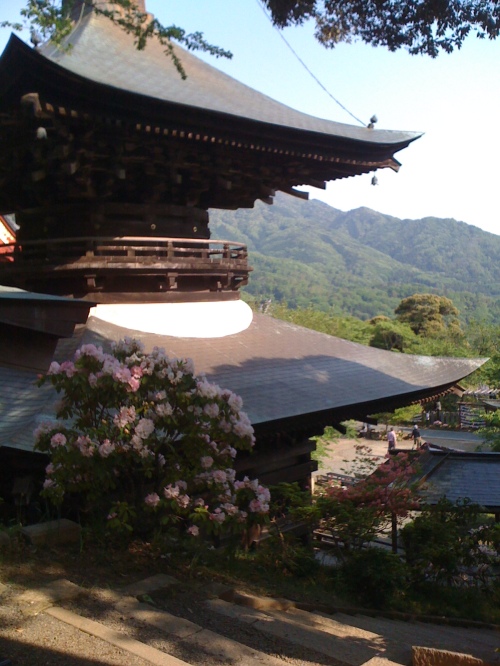Damage and Nukes
On the approach to Narita Airport on Monday afternoon, I thought I could see large irregular shapes in the ocean off Kyujukurihama, not whitecaps, and it looks like what I saw was wreckage. This morning, CBC reports that a large quantity of debris is headed for Hawaii and the west coast.
The Japan Times quotes a Kyodo News wire story that the disaster has resulted in over 80,000 job losses, but says that’s a conservative estimate. The rebuilding process of course, may offset this situation, but must be devastating for business owners and workers (and families) in the region.
The nuclear crisis, too, is unsettling, but when viewed with an eye for scale, it is obvious that the effects are widespread but complex for the immediate region around Fukushima and for Tokyo, which partially depends on produce, goods and electricity from that region. MIT Nuclear Science and Engineering keeps a nuclear incident blog where they log the latest news and put it into context. In Vancouver, the trace radiation levels are decreasing. As a local scientist remarked, detectable does not mean dangerous. The instruments used to measure radiation levels are sensitive to trace amounts, indicating the presence of radioactive particles at a level that has no significant health effects for human beings.
The Japan Times posts a daily update on the radiation levels measured in milisieverts in eastern Japan. While I’m not thrilled to be irradiated, the level I’m exposed to in northern Chiba is negligible. To get a handle on the effects of doses of radiation measured in sieverts, have a look at xkcd’s radiation dose chart. On an intercontinental flight, you are exposed to magnitudes more radiation than you are standing on the ground within the evacuation zone in Fukushima. At the same time, I wouldn’t recommend sticking around there for long, as the dosage per hour has a cumulative effect.
So, yes, it sucks that Fukushima is exhausting waste water into the Pacific in order to make room for yet more contaminated water, and TEPCO is going to have to concrete over the nuke plants, and Fukushima, Miyagi and parts of Iwate Prefectures will only be fit for growing flowers for the next 20 or so years. The radiation won’t get us, but the economic and social fallout is going to going to tax Japanese gaman, the fortitude and endurance of the Japanese.
Aftershocks
Then there are the aftershocks. Thursday night, I had retired to the loft. I live in a wood frame building and the loft during a quake waves like the top of a tree, pretty whippy. The first jolt woke me, and I rolled over, and then the shaking got stronger, so I climbed down the ladder and Skyped home to tell my family that the quake was dramatic but not dangerous for me. USGS says it was a 7.1 magnitude quake. Sadly, some people in Sendai were killed. My family worries about me unnecessarily because they don’t have perspective on the local conditions or the scale of the map and distances from epicenter. I’m far from the action.
Culture and Change
I thought it was just me being sensitive, but I detected a deep social change here. I thought I saw more omoiyari between strangers. Omoiyari is a sense of acceptance and respect for others that often comes out in gesture or action, and sometimes words. In the town, out shopping, talking to neighbours, I felt there was more kindness and patience extended to others. At the pub last night, some local Japanese guys said that their neighbours look out for each other more than ever before. I meet eyes with people more. Japanese people are warm-hearted.
There is ura and omote to Japanese culture, and my girlfriend Eri has noted this. So many disaster survivors show great gaman, endurance, and smile through incredible hardship. She says that western media show these hardy survivors and may give the impression to foreign audiences that things are better than they seem. Those tough people won’t crack, and hold their grief in, showing calm, composed faces to western media. Don’t mistake, she says. There is so much pain there, and people need help.
How to Help

Students' messages of encouragement for Japan
In Vancouver, where I fell back to break out funds, see family, and train with home dojos, I volunteered for 7 days at the University of British Columbia (see the university’s
bulletin), my alma mater, where the
Japan Society had a booth on the student union building concourse to raise awareness of the disaster, and collect funds for Red Cross. The students, many Japanese and Japanese-Canadian, were in need of comfort, and encouragement to go to classes. We had the assistance of many clubs on campus, and vendors who donated part of their sales to the disaster relief fund. Across the city, theaters, restaurants, and businesses are holding fundraising events.
Here in Kashiwa City, Fukushima survivors and their children are housed in public buildings. A handful of children have been welcomed by the schools.
There are many ways to help inside and outside Japan. See Japan Times How to Help page for a huge list of organizations and networks.
Are you holding a fundraising training seminar or is there some local activity you are involved in ? Please post in the comments.


